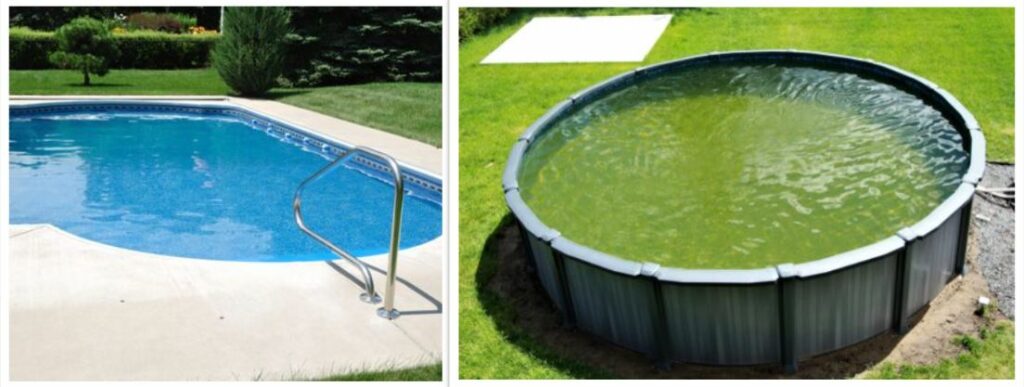Inground pools are often seen as the most expensive option available. That’s usually the case, but not always.
In this short guide, we’ll cover the factors that determine whether an above-ground pool or an inground pool is right for your budget.
We are focusing mainly on installation costs, but we’ll also touch briefly on maintenance and operating expense.
Let’s start by discussing the key differences between these two types of pools that determine their cost.
Above Ground Pools: Cost Factors To Consider
An above-ground pool is typically made of fiberglass, rubber, or a lined concrete shell that typically contains water between 4 feet to 12 feet deep.
Sizes vary from 10-foot inflatable pools to 24’x32′ ovals and 32’x32′ rectangular pools.
These pools are usually placed on the ground directly within a wood or steel structure for support.
Above-ground pools are considered to be the least expensive option available. That said, they are a lot more durable than many people think and can last up to 20 years.
For water filtration, treatment, and circulation above-ground pools and in-ground pools use the same basic types of equipment.
But due to their smaller size, the cost of pump and filter equipment is usually less – as is the ongoing expense of maintaining that equipment.
However, pools sitting above ground are not as easy to clean as in-ground pools. Their sharp vertical walls often must be cleaned manually, which requires a lot of elbow grease.
In addition, the outside of the pool and the structure must be cleaned and painted or sealed from time to time.
One upside is that an above-ground pool will usually not damage the value of your home because it can easily be lifted out and removed.
Inground Pools: Cost Factors To Consider
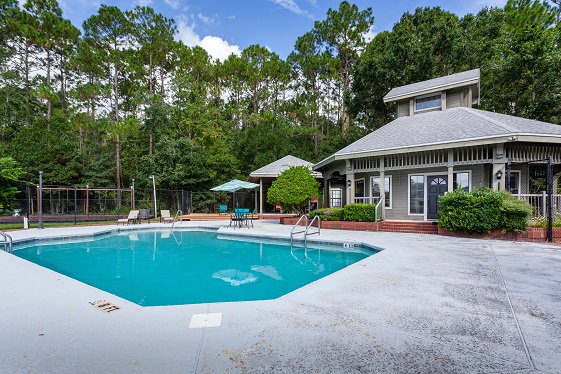
An inground pool is a custom-engineered, permanently-installed structure typically made from cement and fiberglass and installed so that the water level is roughly flush with the ground. Depth is usually graded from a shallow wading end of 4 feet deep to a deeper end suitable for diving (10ft+ deep).
Because they are often contained in or completely made of cement or gunite, in-ground pools are more durable and can last up to 50 years or more, depending on the quality of construction and local conditions.
Because they are made of concrete and usually contain gradual/curved walls that automatic pool cleaners can more easily climb, they are often easier to clean than an above-ground pool.
However, they do have one major drawback: they cannot be moved once installed. In some neighborhoods, inground pools can actually hurt the value of your home, as well.
4 Things to Consider When Choosing between Above Ground Pool & Inground Pools
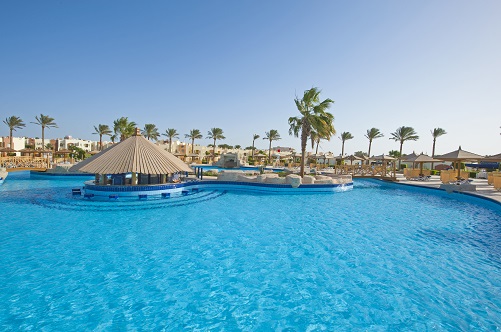
1. Installation Cost
Depending on where you live, the price of installing either type of pool varies widely. The average cost of installing an above-ground pool ranges between $5,000 to $20,000.
An inground pool typically contains twice as much water and costs at least twice as much, or about $20,000 to $100,000.
The size of the pool also affects its price. A larger pool will cost more than a smaller one.
2. Location
Where you choose to build your pool will also affect its overall cost.
If you want to build an inground pool, you must excavate the land and either purchase an expensive molded fiberglass shell or pour a lot of concrete to fabricate it. The labor and heavy equipment also adds more cost.
If you buy a pre-built above-ground pool, you will also need to pay for the installation and to fabricate a structure to house it.
However, you won’t need to pay for the excavation or concrete fill. And heavy equipment is often unnecessary for most installations.
3. Maintenance Costs
Both types of pools require the same kind of pool maintenance. You will need to keep your pool water circulating and clean with a properly-sized pool pump & filtration system.
In addition, you will need to treat your water with anti-biological chemicals – usually by adding chlorine directly to the water or by adding a saltwater chlorination system to your equipment and adding salt to your water to feed it.
That said, being twice the size means inground pools will cost about twice as much to keep them running and clean. In addition, the cost of automatic pool cleaners for larger pools cost more to buy and to keep running.
Above-ground pools should be drained every year, and their filters need to be replaced every two to three years.
Inground pools often do not need to be drained annually, and their filters require replacement every five to seven years.
The cost to replace filters isn’t that much, however – budget $200-$500 for that.
Some types of cement pools will also need to be resurfaced every eight to ten years, as well. Budget $1,000 to $5,000 for this job.
4. Safety Considerations
Above-ground pools are generally considered safer than in-ground pools due to their shallower depth and smaller size which makes it easier to rescue someone.
That said, young children should never be allowed to play in a swimming pool unsupervised.
How Much Does It Cost to Install an In-Ground Pool?
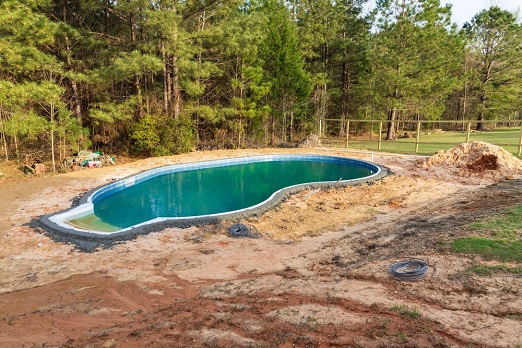
Many factors determine how much money you’ll spend when building an inground pool.
But most people in average-cost areas can expect to pay $20,000 to $60,000 for an average sized in-ground pool.
Factors that impact the cost include the location of the pool, the size of the pool, the construction method and materials used, and the design complexity.
Water features, pool water heaters and chillers, adding a spa or jacuzzi tub, & adding decorative tiling will add complexity and cost, too.
How Much Does It Cost to Install an Above-Ground Pool?
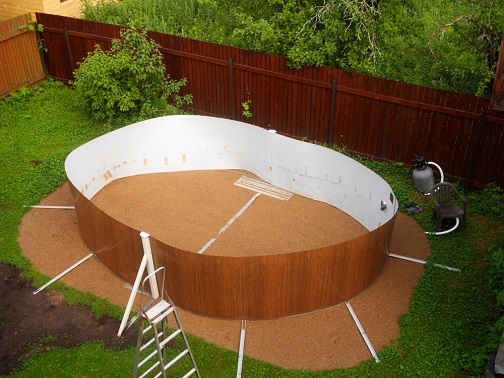
For a small 10-foot inflatable pool in your backyard, you should expect to spend anywhere from $3,000 to $5,000 including a small pump+filter system and a ladder for safety.
If you want to install a larger 24-foot by 16-foot above-ground pool, you will probably end up spending between $10,000 and $20,000 depending on the complexity of containing/support structure required.
For larger above-ground pools, a rigid fiberglass shell will likely cost more than a rubber/vinyl pool in a steel or wooden frame.
Installation costs vary depending on the type of pool you decide to install, but to save money many homeowners can install a modest above-ground pool themselves using ordinary power tools. This is not usually the case with an in-ground pool.
If you choose professional installation, expect to pay your pool installer between $1,000 and $3,000 to get your pool installed.
Benefits of Choosing An Above Ground Pool

1. Less Expensive To Build
Finally, an aboveground pool is cheaper to maintain than an inground pool. You can buy a basic model for under $20,000, including everything you need to keep your pool clean and healthy.
Most models have automatic skimmers, pumps, heaters, and filtration systems.
You can purchase additional equipment at a later date if needed.
2. Less Expensive To Keep Clean
Because they hold less water and have less surface area to clean, most above-ground pools require less expensive pumps and filters and are easier to clean by hand.
You don’t need to purchase an expensive automatic pool cleaner. Instead, just buy a simple suction-side vacuum and a good pool brush and do it yourself.
3. More Customization and Design Options
In-ground pools are usually custom-fabricated to the owner’s wishes. It’s not that hard nor much more expensive to add a curve here, add a submerged seat there, put a few more tiles along the edge, et al.
In contrast, most above-ground pools are quite limited in design choice and tend to look a bit wieldy and ugly. That said, if your pool is in a fenced back yard – who really cares?
FAQs

Q: How Much Does An Above-Ground Pool Cost?
A: Depending on the size and features you choose, you can expect to pay between $5,000 and $20,000 for a fully-installed, equipped, and safe above-ground pool made of rubber, vinyl, and/or fiberglass.
Q: What Size Pool Do I Need For My Family?
A: The average family of 4 typically requires a pool of 5,000 gallons to 20,000 gallons, depending on the kind of water activities they engage in. Diving pools are significantly larger than wading pools, for example.
Q: Is There Anything I Should Look Out For When Buying An Above-Ground Pool?
A: Yes, there are many things you should consider including the type of material, the water depth and pool dimensions, whether it will be installed on-grade vs. semi-buried, and the type of deck and structure you will need.
Q: How Many People Do I Need To Help Me Install An Above-Ground Pool?
A: Most people can install an above-ground pool themselves using common house tools and 1-2 friends with a weekend to spare. However, you can always hire a contractor to help you if your budget allows.
Q: How Long Will It Take To Install An Above-Ground Pool?
Typically, installing an above-ground pool takes a few days to a few weeks to complete. The time is mostly dependent on whether you need to build a structure and/or hire a contractor to complete the job.
Q: What Type Of Pool Material Should I Use?
A: Concrete or gunite are usually used as the material for most below-grade or semi-buried pools. It’s durable, easy to maintain, and can be coated with many design features and colors.
For above-ground pools, the most popular choices are inflatable vinyl, rigid polyurethane or rubber, and fiberglass shell. Some larger above ground pools may require a concrete foundation, as well.
Q: What Kind Of Pool Features Should I Always Include In My Design?
A: You should include at least two steps or ladders in every pool design so that swimmers have two ingress/egress points for safety reasons. These can also be molded stairs.
Q: What Are Some Common Problems With Above-Ground Pools?
A: The most common issues unique to above-ground pools include the risk of leaks, catastrophic failure of the pool container, and faulty structure/decking. These issues are mostly not present in in-ground pools.
Q: What Type of Pool Has A Higher Return On Investment (ROI): Above-Ground or In-Ground?
A: This ultimately boils down to whether the pool increases or decreases the value of your property when it comes to selling your home.
Each neighborhood values a high-quality pool differently, so make sure you ask a local realtor or two before finalizing your decision.
Q: How Often Should I Maintain My Pool?
A: All types of pools require weekly cleaning while in use, at a bare minimum. In addition, you need to keep them clear of leaves and debris. Otherwise, algae will grow quickly.
Q: Can I Repair Leaks In My Above-Ground Pool?
A: Yes. And it’s not that difficult to do on your own in most cases. If you notice any leaks while you’re swimming, take note of where the leak is coming from.
Look online for a patch kit that matches your pool’s material (vinyl or rubber in most cases).
Conclusion
There are many reasons why you might want to consider building an above-ground pool instead of an inground pool.
However, it’s important to remember that the decision mostly comes down to your maximum out-of-pocket budget and personal preferences.

